Coastal vulnerability
This section draws together studies that focus on the impacts of sea-level rise on the world’s coastlines. It showcases a broad range of research, from coastal ecosystem vulnerability to increasing risk of extreme sea levels, to mitigating options.
Patterns of island change and persistence offer alternate adaptation pathways for atoll nations
Paul S. Kench et al., Nat. Commun. 9 605 (2018)
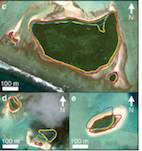 Inundation and erosion could make many atoll islands uninhabitable over the next century. Here the authors present an analysis of change in the atoll nation of Tuvalu that shows a 2.9% increase in land area over the past four decades, with 74% of islands increasing in size, despite rising sea levels.
Inundation and erosion could make many atoll islands uninhabitable over the next century. Here the authors present an analysis of change in the atoll nation of Tuvalu that shows a 2.9% increase in land area over the past four decades, with 74% of islands increasing in size, despite rising sea levels.
Potential increase in coastal wetland vulnerability to sea-level rise suggested by considering hydrodynamic attenuation effects
José F. Rodríguez et al., Nat. Commun. 8 16094 (2017)
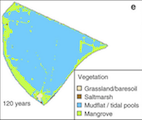 Coastal wetlands are particularly vulnerable to sea-level rise. However, estimates of wetland submergence are highly uncertain due to insufficient understanding of hydrodynamic processes. Here the authors overcome this by using a detailed hydrodynamic model to determine the attenuation effect of vegetation and infrastructure. They show that including attenuation effects improves prediction of wetland evolution and suggests increases in wetland vulnerability to sea-level rise.
Coastal wetlands are particularly vulnerable to sea-level rise. However, estimates of wetland submergence are highly uncertain due to insufficient understanding of hydrodynamic processes. Here the authors overcome this by using a detailed hydrodynamic model to determine the attenuation effect of vegetation and infrastructure. They show that including attenuation effects improves prediction of wetland evolution and suggests increases in wetland vulnerability to sea-level rise.
Vegetation recovery in tidal marshes reveals critical slowing down under increased inundation
Jim van Belzen et al., Nat. Commun. 8 15811 (2017)
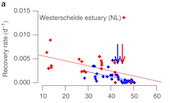 Tidal marshes are vulnerable to sea-level rise but our ability to predict their response is limited due to non-linear behaviour, which can lead to catastrophic shifts. Here, van Belzen and colleagues use observations and experiments to show that vegetation recovery in tidal marsh ecosystems slows down as inundation increases.
Tidal marshes are vulnerable to sea-level rise but our ability to predict their response is limited due to non-linear behaviour, which can lead to catastrophic shifts. Here, van Belzen and colleagues use observations and experiments to show that vegetation recovery in tidal marsh ecosystems slows down as inundation increases.
Thomas Wahl et al., Nat. Commun. 8 16075 (2017)
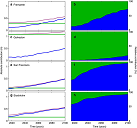 The increased intensity and frequency of extreme sea levels has resulted in higher coastal flood risk. However, uncertainties in contemporary extreme sea levels from mean sea-level rise projections have been overlooked in broad-scale risk and adaptation studies. Here, the authors quantify the uncertainties in present-day global extreme sea level estimates and find that they exceed those from global sea level rise projections. Uncertainties in extreme sea levels need to considered for robust sea-level rise projections.
The increased intensity and frequency of extreme sea levels has resulted in higher coastal flood risk. However, uncertainties in contemporary extreme sea levels from mean sea-level rise projections have been overlooked in broad-scale risk and adaptation studies. Here, the authors quantify the uncertainties in present-day global extreme sea level estimates and find that they exceed those from global sea level rise projections. Uncertainties in extreme sea levels need to considered for robust sea-level rise projections.
Vulnerability of Louisiana’s coastal wetlands to present-day rates of relative sea-level rise
Krista L. Jankowski et al., Nat. Commun. 8 14792 (2017)
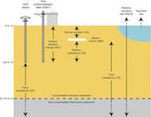 Rates of relative sea-level rise are amongst the world’s highest in coastal Louisiana. Marsh resilience to rising seas depends on whether surface elevation gain outpaces relative sea-level rise rates. Here the authors analyse an unprecented dataset of surface-elevation and compare it with present-day relative sea level rise rates to determine wetland vulnerability. They find that wetlands in the westernmost portion of coastal Louisiana exhibit an accretion deficit, making them highly vulnerable to relative sea-level rise.
Rates of relative sea-level rise are amongst the world’s highest in coastal Louisiana. Marsh resilience to rising seas depends on whether surface elevation gain outpaces relative sea-level rise rates. Here the authors analyse an unprecented dataset of surface-elevation and compare it with present-day relative sea level rise rates to determine wetland vulnerability. They find that wetlands in the westernmost portion of coastal Louisiana exhibit an accretion deficit, making them highly vulnerable to relative sea-level rise.
Spatially integrative metrics reveal hidden vulnerability of microtidal salt marshes
Neil K. Ganju et al., Nat. Commun. 8 14156 (2017)
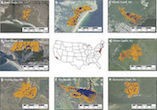 Microtidal marshes are the most vulnerable to future sea-level rise due to their strong dependence on sediment availability. However, sediment fluxes vary on rapid timescales, which cannot be captured by point measurements historically used to assess vulnerability. Here, the authors acquire continuous measurements for at least two months from sites along the coast of the United States showing that two geomorphic-based, spatiotemporally integrative metrics reveal vulnerability not captured by traditional metrics.
Microtidal marshes are the most vulnerable to future sea-level rise due to their strong dependence on sediment availability. However, sediment fluxes vary on rapid timescales, which cannot be captured by point measurements historically used to assess vulnerability. Here, the authors acquire continuous measurements for at least two months from sites along the coast of the United States showing that two geomorphic-based, spatiotemporally integrative metrics reveal vulnerability not captured by traditional metrics.
A global reanalysis of storm surges and extreme sea levels
Sanne Muis et al., Nat. Commun. 7 11969 (2016)
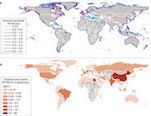 Current datasets, or techniques to analyse coastal flood risks, such as the Dynamic Interactive Vulnerability Assessment (DIVA) database are based on extreme events, and perform poorly regarding the assessment of inter annual variability, the impact of changing regimes or past changes, for which times series are needed. Tide gauges are available, but only in a few locations, and over varying and limited timescales. Here the authors develop the Global Tide and Surge Reanalysis dataset (GTSR), based on hydrodynamic model simulations and a newly developed Global Tide and Surge Model.
Current datasets, or techniques to analyse coastal flood risks, such as the Dynamic Interactive Vulnerability Assessment (DIVA) database are based on extreme events, and perform poorly regarding the assessment of inter annual variability, the impact of changing regimes or past changes, for which times series are needed. Tide gauges are available, but only in a few locations, and over varying and limited timescales. Here the authors develop the Global Tide and Surge Reanalysis dataset (GTSR), based on hydrodynamic model simulations and a newly developed Global Tide and Surge Model.
The effectiveness of coral reefs for coastal hazard risk reduction and adaptation
Filippo Ferrario et al., Nat. Commun. 5 3794 (2014)
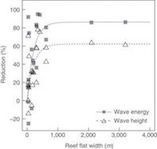 Billions of US dollars from developed nations are being poured into funding coastal defences for those at risk. Here the authors provide the first quantitative meta-analysis of the role of coral reefs in reducing wave energy across reefs in the Indian, Pacific, and Atlantic Oceans. They show that reef environments can reduce wave energy and height by up to 97% and 85% respectively. Coral reefs can deliver wave attenuation benefits similar to or greater than artificial structures at a fraction of the cost. The authors show that nearly 200 million people may receive risk reduction benefits from reefs or bear costs if the reefs are lost or degraded.
Billions of US dollars from developed nations are being poured into funding coastal defences for those at risk. Here the authors provide the first quantitative meta-analysis of the role of coral reefs in reducing wave energy across reefs in the Indian, Pacific, and Atlantic Oceans. They show that reef environments can reduce wave energy and height by up to 97% and 85% respectively. Coral reefs can deliver wave attenuation benefits similar to or greater than artificial structures at a fraction of the cost. The authors show that nearly 200 million people may receive risk reduction benefits from reefs or bear costs if the reefs are lost or degraded.

